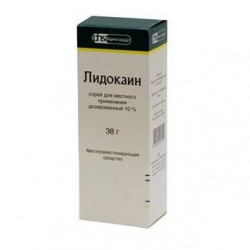



 All payments are encrypted via SSL
All payments are encrypted via SSL
 Full Refund if you haven't received your order
Full Refund if you haven't received your order
Spray dosed for local use.
38 g
LIDOKAIN - local anesthetic effect due to the blockade of voltazhzavisimy Na + channels, which prevents the generation of impulses in the terminations of the sensory nerves and the conduct of pain impulses along the nerve fibers. When applied topically dilates blood vessels, has no local irritating action. The effect develops after 1-5 minutes after application to the mucous membranes or skin and lasts 30-60 minutes (aerosol for topical use - 10-15 minutes, gel for local use - 15-20 minutes).
Terminal (surface) anesthesia of mucous membranes: in dentistry (anesthesia of the injection area before local anesthesia, suturing on the mucous membrane, extirpation of milk teeth, removal of tartar), otorhinolaryngology (operations on the nasal septum, electrocoagulation, etc.), obstetrics and gynecology (episiotomy and incision treatment, removal of sutures, interventions on the vagina and cervix, etc.); with instrumental and endoscopic examinations (probe insertion, rectoscopy, intubation, etc.), X-ray examination (elimination of nausea and pharyngeal reflex); as an analgesic drug for burns (including solar), bites, contact dermatitis (including caused by irritating plants), small wounds (includingscratches); surface anesthesia of the skin with minor surgical interventions.
Hypersensitivity.C caution. Hemorrhoidal bleeding (for rectal examination), local infection in the area of application, injury to the mucous membrane or skin in the area of application, acute illness, debilitated patients, younger children, old age, pregnancy, lactation.
Locally, in dentistry, otolaryngology - 1-4 doses, with endoscopic and instrumental methods of research - 2-3 doses, in obstetrics - 15-20 doses, gynecology - 4-5 doses, dermatology - 1-3 doses. The maximum dose is 40 doses / 70 kg of body weight. In children in dental practice, it is preferable to use in the form of lubrication (to avoid the patient's fright when spraying) by prior impregnation of a cotton swab.
During the period of treatment, care must be taken when driving vehicles and engaging in other potentially hazardous activities that require increased concentration and psychomotor speed.
Cimetidine and propranolol reduce hepatic clearance of lidocaine (reduced metabolism due to inhibition of microsomal oxidation and decreased hepatic blood flow) and increase the risk of toxic effects (includingstunned condition, drowsiness, bradycardia, paresthesias, etc.). Barbiturates, phenytoin, rifampicin (inducers of liver microsomal enzymes) reduce efficacy (may require an increase in dose). When prescribed with amamalin, phenytoin, Verapamil, quinidine, Amiodarone, the negative inotropic effect may be enhanced. Joint appointment with beta-blockers increases the risk of developing bradycardia. Cardiac glycosides weaken the cardiotonic effect, curare-like drugs enhance muscle relaxation. Procainamide increases the risk of developing CNS arousal, hallucinations. With the simultaneous appointment of lidocaine and hypnotic and sedative drugs may increase their inhibitory effect on the central nervous system. With the on / in the introduction of hexobarbital or sodium thiopental on the background of the action of lidocaine, respiratory depression is possible. Under the influence of MAO inhibitors, it is possible to enhance the local anesthetic action of lidocaine. Patients taking MAO inhibitors should not be given lidocaine parenterally. With simultaneous use of lidocaine and polymyxin B, it is possible to increase the inhibitory effect on the neuromuscular transmission, therefore in this case it is necessary to monitor the patient's respiratory function.
Symptoms: increased sweating, paleness of the skin, dizziness, headache, blurred vision, tinnitus, diplopia, decreased blood pressure, bradycardia, arrhythmia, drowsiness, chills, numbness, tremor, anxiety, agitation, convulsions, methemoglobinemia, heart failure.
Treatment: at the first signs of intoxication (dizziness, nausea, vomiting, euphoria), further introduction is stopped, the patient is transferred to a horizontal position; prescribe inhalation of oxygen; with convulsions - in / in 10 mg of diazepam; in bradycardia, m-anticholinergics (atropine), vasoconstrictors (norepinephrine, phenylephrine). Dialysis is ineffective.
